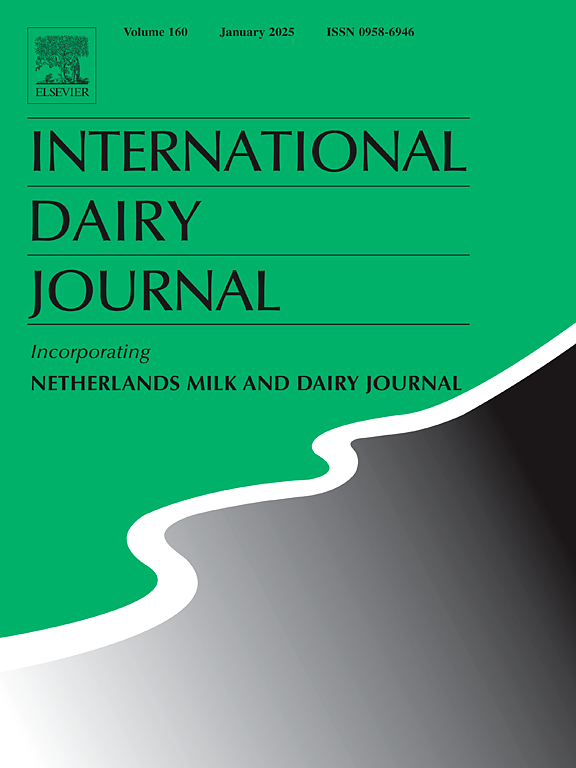Ripening dynamics in Muş Tulum cheese: physicochemical changes, free fatty acid composition and aroma profile evolution
IF 3.4
3区 农林科学
Q2 FOOD SCIENCE & TECHNOLOGY
引用次数: 0
Abstract
This study investigated the changes in specific physicochemical properties, free fatty acid (FFA) profiles, and volatile aroma components during the 90-day ripening period of Muş Tulum cheese produced by five dairy factories (A–E). Significant differences (p < 0.05) were observed between factories and ripening periods in dry matter, fat content, fat in dry matter, protein, salt in dry matter, titratable acidity, and pH values. FFA analysis revealed that the most abundant fatty acids (FA) were C18:1 (oleic acid), C16:0 (palmitic acid), and C18:0 (stearic acid), and total FFA and unsaturated fatty acid (UFA) levels increased over time, particularly in samples from factories A and B. 75 volatile compounds were identified, including 19 acids, 20 esters, 7 hydrocarbons, 6 alcohols, 2 aldehydes, 1 ketone, 2 terpenes, 1 lactone, and 17 other compounds. These results indicate that production conditions and ripening duration play a critical role in the chemical composition and aroma development of Muş Tulum cheese. Moreover, this study provides a significant contribution to the literature by being based on real production conditions, allowing the observation of differences between industrial and traditional cheeses and enabling the monitoring of chemical changes over a 90-day storage period.
穆图伦奶酪的成熟动力学:理化变化、游离脂肪酸组成和香气谱演变
研究了5家乳品厂(A-E)生产的穆乌图卢姆奶酪在90天成熟过程中特定理化性质、游离脂肪酸(FFA)谱和挥发性香气成分的变化。干物质、脂肪含量、干物质脂肪含量、蛋白质、干物质盐含量、可滴定酸度和pH值在工厂和成熟期之间存在显著差异(p < 0.05)。FFA分析显示,最丰富的脂肪酸(FA)是C18:1(油酸)、C16:0(棕榈酸)和C18:0(硬脂酸),总FFA和不饱和脂肪酸(UFA)水平随着时间的推移而增加,特别是在A工厂和b工厂的样品中,鉴定出75种挥发性化合物,包括19种酸、20种酯、7种碳氢化合物、6种醇、2种醛、1种酮、2种萜烯、1种内酯和17种其他化合物。这些结果表明,生产条件和成熟时间对穆乌图伦奶酪的化学成分和香气发展起着至关重要的作用。此外,该研究基于真实的生产条件,可以观察工业奶酪和传统奶酪之间的差异,并可以监测90天储存期内的化学变化,从而对文献做出了重大贡献。
本文章由计算机程序翻译,如有差异,请以英文原文为准。
求助全文
约1分钟内获得全文
求助全文
来源期刊

International Dairy Journal
工程技术-食品科技
CiteScore
6.50
自引率
9.70%
发文量
200
审稿时长
49 days
期刊介绍:
The International Dairy Journal publishes significant advancements in dairy science and technology in the form of research articles and critical reviews that are of relevance to the broader international dairy community. Within this scope, research on the science and technology of milk and dairy products and the nutritional and health aspects of dairy foods are included; the journal pays particular attention to applied research and its interface with the dairy industry.
The journal''s coverage includes the following, where directly applicable to dairy science and technology:
• Chemistry and physico-chemical properties of milk constituents
• Microbiology, food safety, enzymology, biotechnology
• Processing and engineering
• Emulsion science, food structure, and texture
• Raw material quality and effect on relevant products
• Flavour and off-flavour development
• Technological functionality and applications of dairy ingredients
• Sensory and consumer sciences
• Nutrition and substantiation of human health implications of milk components or dairy products
International Dairy Journal does not publish papers related to milk production, animal health and other aspects of on-farm milk production unless there is a clear relationship to dairy technology, human health or final product quality.
 求助内容:
求助内容: 应助结果提醒方式:
应助结果提醒方式:


